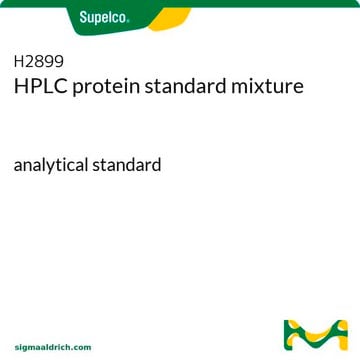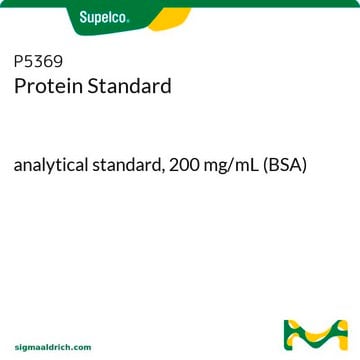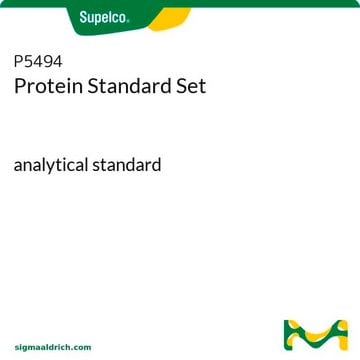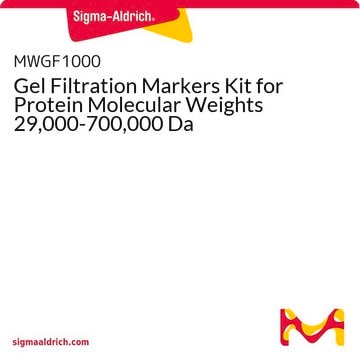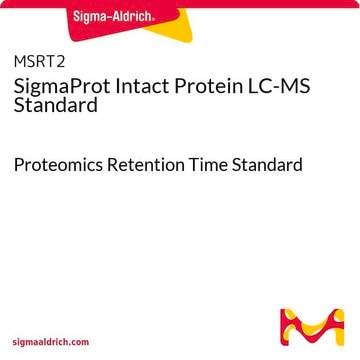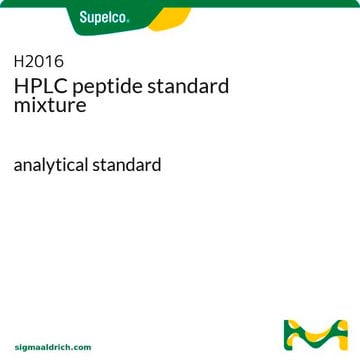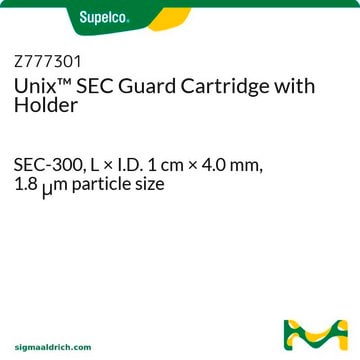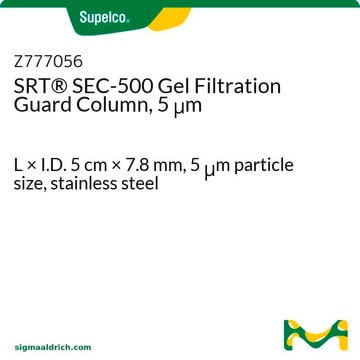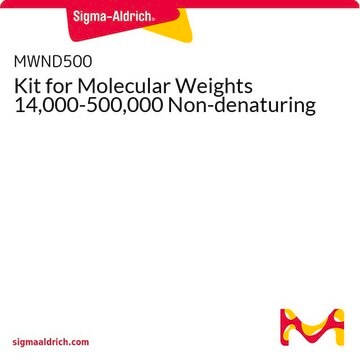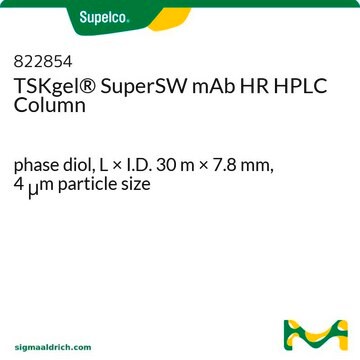69385
Protein Standard Mix 15 - 600 kDa
for size exclusion chromatography
Sign Into View Organizational & Contract Pricing
All Photos(1)
About This Item
UNSPSC Code:
85151701
NACRES:
NA.24
Recommended Products
Quality Level
form
solid
mol wt
15-600 kDa
analyte chemical class(es)
amino acids, peptides, proteins
technique(s)
gel permeation chromatography (GPC): suitable
application(s)
clinical
food and beverages
pharmaceutical
format
neat
storage temp.
−20°C
General description
The protein standard mix is a calibration standard to test and monitor performance of size exclusion chromatography (SEC) columns. It is a lyophilized mixture of molecular weight markers ranging from 15 kDa to 600 kDa.
Components
Thyroglobulin bovine MW ~ 670 000 Da
γ-globulins from bovine blood MW ~ 150 000 Da
Ovalbumin MW~ 44 300 Da
Ribonuclease A type I-A MW ~ 13 700 Da
p-aminobenzoic acid (pABA) MW ~ 137 Da
Components
Thyroglobulin bovine MW ~ 670 000 Da
γ-globulins from bovine blood MW ~ 150 000 Da
Ovalbumin MW~ 44 300 Da
Ribonuclease A type I-A MW ~ 13 700 Da
p-aminobenzoic acid (pABA) MW ~ 137 Da
Application
This analytical standard is used for the following:
- Evaluation of selectivity and separation efficiency of size exclusion chromatography (SEC) to separate intact proteins by varying flow rate, size of silica particles and pore sizes in the column
- Simultaneous determination of oligomerized and nitrated proteins by size exclusion chromatography-high performance liquid chromatography-diode array detection (SEC-HPLC-DAD)
- Molecular weight separation of proteins by size-exclusion chromatography, formed upon O3 and NO2 induced oxidation, nitration, and oligomerization of bovine serum albumin (BSA) as a model protein
- Estimation of molecular masses of two recombinant proteins— TNF fluorescent sensor (BTN-Kat) and fluorescent sensor-inhibitor (ITN-Kat), by size exclusion chromatography (SEC) to evaluate their ability of binding and neutralizing tumor necrosis factor (TNF) in vitro and further serving as imaging labels for non-invasive analysis
related product
Product No.
Description
Pricing
Signal Word
Danger
Hazard Statements
Precautionary Statements
Hazard Classifications
Acute Tox. 4 Dermal - Acute Tox. 4 Inhalation - Acute Tox. 4 Oral - Aquatic Chronic 3 - Resp. Sens. 1
Storage Class Code
11 - Combustible Solids
WGK
WGK 3
Flash Point(F)
Not applicable
Flash Point(C)
Not applicable
Choose from one of the most recent versions:
Already Own This Product?
Find documentation for the products that you have recently purchased in the Document Library.
Customers Also Viewed
Beata Maria Walter et al.
Protein expression and purification, 169, 105587-105587 (2020-02-01)
Prs (phosphoribosyl pyrophosphate synthase) is a broadly conserved protein that synthesises 5-phosphoribosyl 1-pyrophospate (PRPP); a substrate for biosynthesis of at least 10 enzymatic pathways including biosynthesis of DNA building blocks - purines and pyrimidines. In Escherichia coli, it is a
Robert C Monsen et al.
Nucleic acids research, 48(10), 5720-5734 (2020-02-23)
The structure of the 68 nt sequence with G-quadruplex forming potential within the hTERT promoter is disputed. One model features a structure with three stacked parallel G-quadruplex units, while another features an unusual duplex hairpin structure adjoined to two stacked
Yang Wang et al.
Nature communications, 13(1), 4614-4614 (2022-08-09)
Single-chain variable fragments (scFvs), composed of variable domains of heavy and light chains of an antibody joined by a linker, share antigen binding capacity with their parental antibody. Due to intrinsically low solubility and stability, only two Escherichia coli-produced scFvs
Simultaneous determination of nitrate and oligomerized proteins by size exclusion high-performance liquid chromatography coupled to photodiode array detection.
Liu F, et al.
Journal of Chromatography A, 1495, 76-82 (2017)
Robert C Monsen et al.
Nucleic acids research, 49(3), 1749-1768 (2021-01-21)
Human telomeres contain the repeat DNA sequence 5'-d(TTAGGG), with duplex regions that are several kilobases long terminating in a 3' single-stranded overhang. The structure of the single-stranded overhang is not known with certainty, with disparate models proposed in the literature.
Our team of scientists has experience in all areas of research including Life Science, Material Science, Chemical Synthesis, Chromatography, Analytical and many others.
Contact Technical Service